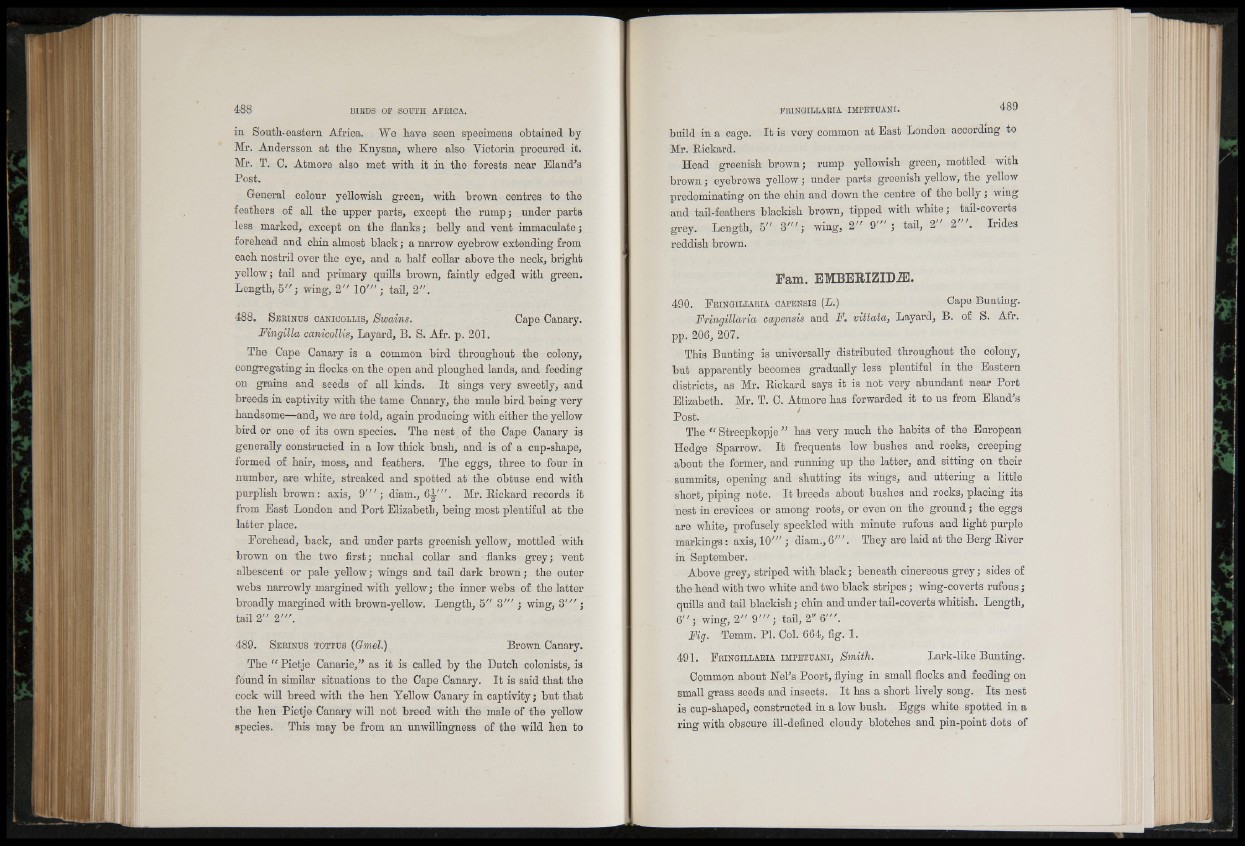
in South-eastern Africa. We have seen specimens obtained by
Mr. Andersson at the Knysna, where also Victorin procured it.
Mr. T. 0. Atmore also met with it in the forests near Eland’s
Post.
General colour yellowish green, with brown centres to the
feathers of all the upper parts, except the rump; under parts
less marked, except on the flanks; belly and vent immaculate;
forehead and chin almost black; a narrow eyebrow extending from
each nostril over the eye, and a half collar above the neck, bright
yellow; tail and primary quills brown, faintly edged with green.
Length, 5 " ; wing, 2" 1 0 " '; tail, 2".
488. S e r in it s c a n ic o b l is , Swains. Cape Canary.
Fingilla camcollis, Layard, B. S. Afr. p. 201.
The Cape Canary is a common bird throughout the colony,
congregating in flocks on the open and ploughed lands, and feeding
on grains and seeds of all kinds. It sings very sweetly, and
breeds in captivity with the tame Canary, the mule bird being very
handsome—and, we are told, again producing with either the yellow
bird or one of its own species. The nest of the Cape Canary is
generally constructed in a low thick bush, and is of a cup-shape,
formed of hair, moss, and feathers. The eggs, three to four in
number, are white, streaked and spotted at the obtuse end with
purplish brown: axis, 9 " '; diam., 6^"'. Mr. Rickard records it
from East London and Port Elizabeth, being most plentiful at the
latter place.
Forehead, back, and under parts greenish yellow, mottled with
brown on the two first; nuchal collar and flanks grey; vent
albescent or pale yellow; wings and tail dark brown; the outer
webs narrowly margined with yellow; the inner webs of the latter
broadly margined with brown-yellow. Length, 5” 3 " '; wing, 3 " ' ;
tail 2" 2 " ’.
489. S e r in u s t o t t u s (Gmel.) Brown Canary.
The “ Pietje Canarie,” as it is called by the Dutch colonists, is
found in similar situations to the Cape Canary. It is said that the
cock will breed with the hen Yellow Canary in captivity; but that
the hen Pietje Canary will not breed with the male of the yellow
species. This may be from an unwillingness of the wild hen to
build in a cage. It is very common at East London according to
Mr. Rickard.
Head greenish brown; rump yellowish green, mottled with
brown; eyebrows yellow; under parts greenish yellow, the yellow
predominating on the chin and down the centre of the belly; wing
and tail-feathers blackish brown, tipped with white; tail-coverts
grey. Length, 5" 3" ' ; wing, 2" 9 ” ; tail, 2 2 . Irides
reddish brown.
Earn. EMBERIZID2E.
490. F r in g im a r ia ca pens is ( T j . ) Cape Bunting.
Fringillaria capensis and F. vittata, Layard, B. of S. Afr.
pp. 206, 207.
This Bunting is universally distributed throughout the colony,
but apparently becomes gradually less plentiful in the Eastern
districts, as Mr. Rickard says it is not very abundant near Port
Elizabeth. Mr. T. C. Atmore has forwarded it to us from Eland’s
Post.
The “ Streepkopje ” has very much the habits of the European
Hedge Sparrow. It frequents low bushes and rocks, creeping
about the former, and running up the latter, and sitting on their
summits, opening and shutting its wings, and uttering a little
short, piping note. It breeds about bushes and rocks, placing its
nest in crevices or among roots, or even on the ground; the eggs
are white, profusely speckled with minute rufous and light purple
markings: axis, 1 0 " '; diam., 6'". They are laid at the Berg River
in September.
Above grey, striped with black; beneath cinereous grey; sides of
the head with two white and two black stripes; wing-coverts rufous;
quills and tail blackish; chin and under tail-coverts whitish. Length,
6 " ; wing, 2" 9 '" ; tail, 2" 6'".
Fig. Temm. PI. Col. 664, fig. 1.
491. F r in g il la r ia im p e tu a n i, Smith. Lark-like Bunting.
Common about Nel’s Poort, flying in small flocks and feeding on
small grass seeds and insects. It has a short lively song. Its nest
is cup-shaped, constructed in a low bush. Eggs white spotted in a
ring with obscure ill-defined cloudy blotches and pin-point dots of